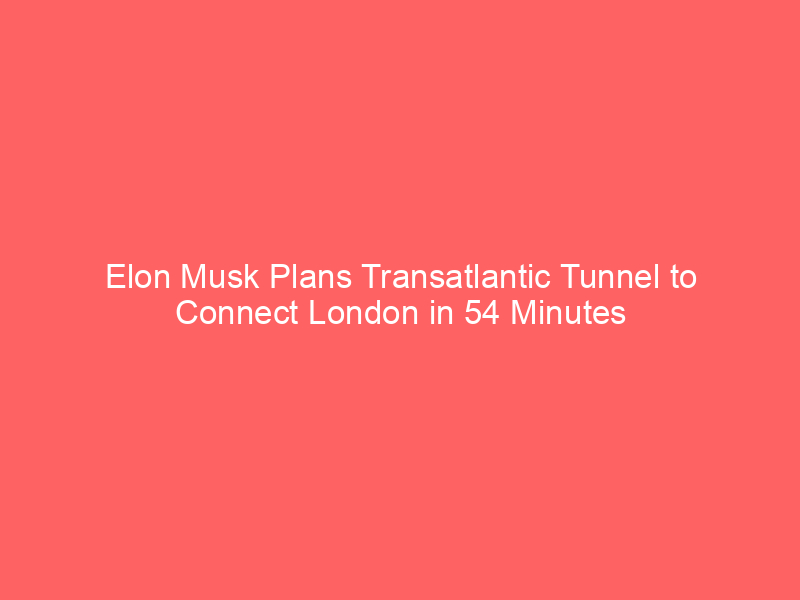In a bold move that captures the imagination of tech enthusiasts and urban planners alike, Elon Musk has announced an unprecedented project: a transatlantic tunnel that would connect London to New York in just 54 minutes. Valued at a staggering 20 trillion euros, this ambitious infrastructure endeavor aims to revolutionize international travel and redefine global connectivity. As futuristic as it sounds, Musk’s vision pushes the boundaries of engineering, financing, and logistics, signaling a new era in transportation technology. While the idea sparks excitement, it also invites skepticism regarding its feasibility and the immense hurdles that lie ahead.
Elon Musk’s Ambitious Plan for a Transatlantic Tunnel Connecting London
Elon Musk’s proposed transatlantic tunnel is envisioned as a marvel of engineering, utilizing advanced vacuum tube technology to enable ultra-high-speed transit. The plan involves constructing a network of tunnels stretching beneath the Atlantic Ocean, with the goal of drastically reducing travel time between London and New York. Musk’s companies, such as Tesla and The Boring Company, are expected to spearhead the project, leveraging innovative tunneling methods and cutting-edge materials to make the impossible possible. The project’s scale is mind-boggling, requiring international cooperation, massive investments, and groundbreaking technological breakthroughs that could set new standards for future infrastructure projects.
However, the financial implications are enormous, with costs estimated at around 20 trillion euros—an astronomical figure that raises questions about funding and economic viability. Musk has hinted at potential partnerships with governments, private investors, and technological allies to make the project happen, but securing such massive capital remains a formidable challenge. Additionally, navigating international regulations, environmental concerns, and logistical complexities adds further layers of difficulty. Despite these obstacles, Musk’s visionary approach emphasizes that no goal is too ambitious if innovation and determination are front and center.
Environmental and safety considerations also play a crucial role in this ambitious plan. Building a tunnel across the Atlantic involves tackling issues related to marine ecosystems, seismic activity, and emergency protocols for passenger safety. Musk’s team is reportedly exploring sustainable construction practices and resilient tunnel designs to address these concerns. While the project is still in its conceptual stages, Musk’s commitment suggests that he believes technological advancements will eventually overcome these hurdles. If successful, this tunnel could redefine how we think about international travel and open new doors for human connectivity.
Could a 54-Minute Journey Between London and New York Become Reality?
The idea of traveling between London and New York in just under an hour is undeniably captivating, but achieving it involves overcoming tremendous technical challenges. Current transportation methods—airplanes, ships, and traditional tunnels—are nowhere near capable of such speed, and the technological leap required is immense. Musk’s concept relies on vacuum tubes and magnetic levitation trains, which could theoretically reach hypersonic speeds, but engineering such a system to operate safely across the Atlantic poses unprecedented hurdles. Factors such as maintaining stable environments, managing extreme pressures, and ensuring passenger safety demand breakthroughs that are still in the realm of theory.
Financially, the project’s estimated cost of 20 trillion euros is staggering, and raising such capital would require unprecedented international collaboration and long-term commitment. Governments, private investors, and global financial institutions would need to align their interests, which is no small feat in today’s complex geopolitical landscape. Moreover, the economic benefits of such a tunnel—like boosting trade and tourism—must be weighed against the enormous initial investment and potential environmental impacts. Skeptics argue that the cost might outweigh the benefits, especially considering the uncertainty around technological feasibility and long-term sustainability.
Despite these challenges, Musk remains optimistic about the future, emphasizing that innovation often starts with seemingly impossible ideas. If technological advancements in vacuum tube transport and tunneling techniques continue at their current pace, what today seems science fiction could someday become reality. While a 54-minute transatlantic journey remains speculative, the project serves as a symbol of human ingenuity and the relentless pursuit of progress. Whether it materializes or not, Musk’s bold vision encourages a reevaluation of what’s possible in transportation and international connectivity.
Elon Musk’s audacious plan to create a transatlantic tunnel linking London to New York in less than an hour exemplifies the spirit of pushing technological boundaries. While the vision is inspiring and could revolutionize global travel, it faces significant technical, financial, and environmental challenges that are yet to be fully addressed. As the world watches with curiosity and cautious optimism, this project highlights the potential for innovation to transform our future—reminding us that sometimes, the most extraordinary ideas are worth pursuing. Whether or not the tunnel becomes a reality, Musk’s initiative sparks a global conversation about the limits of engineering and the limitless possibilities of human imagination.







